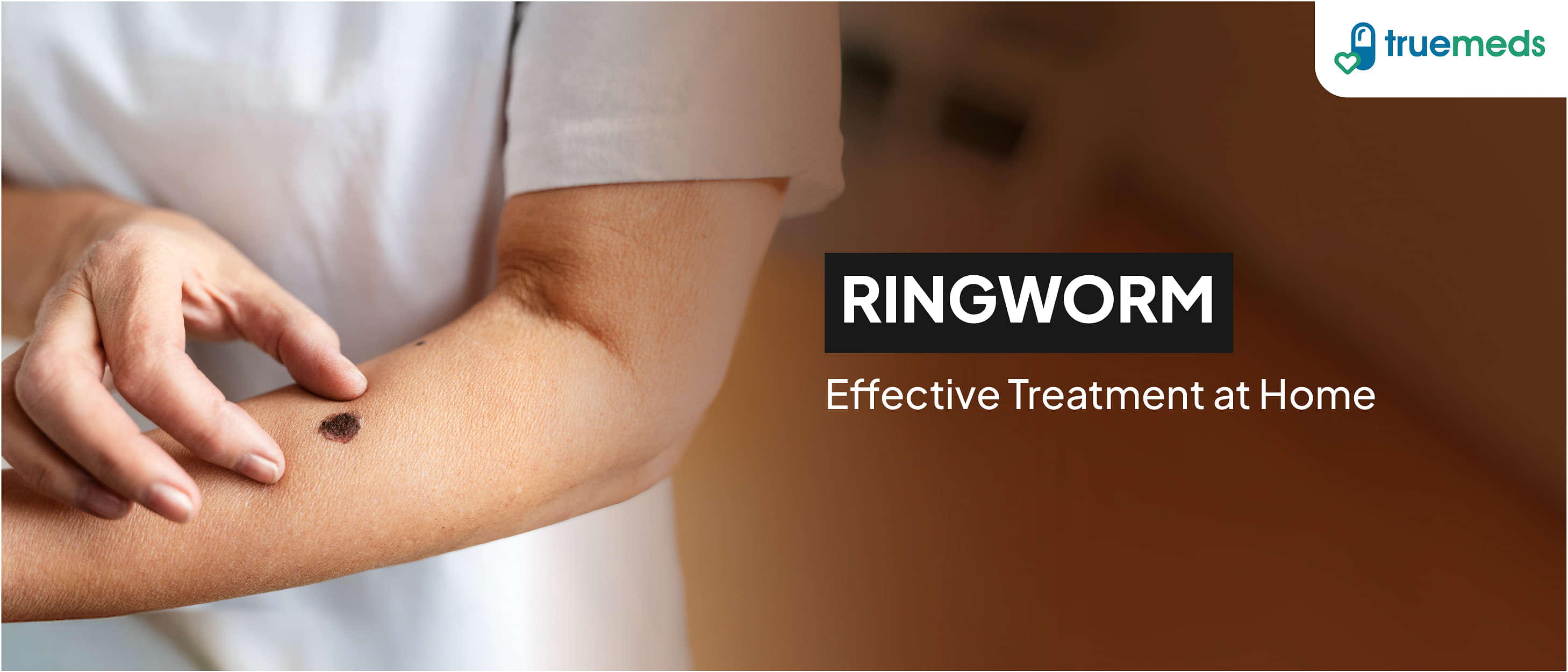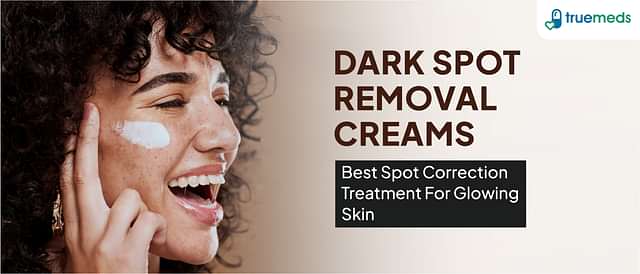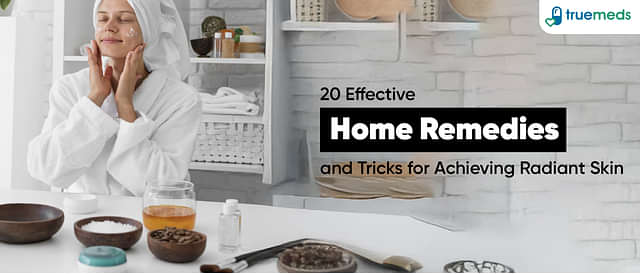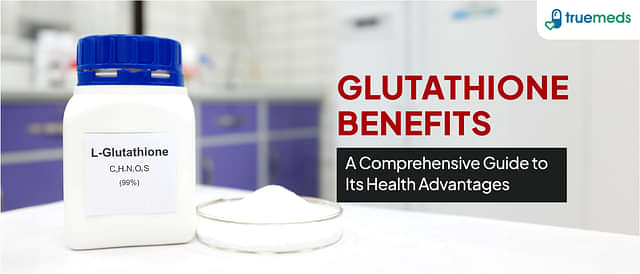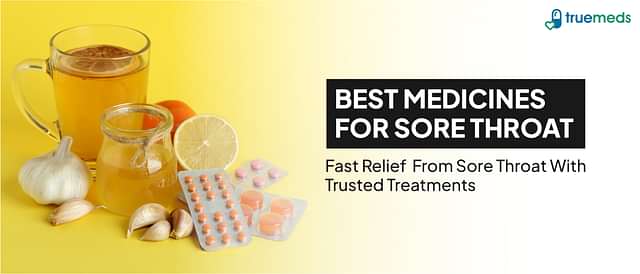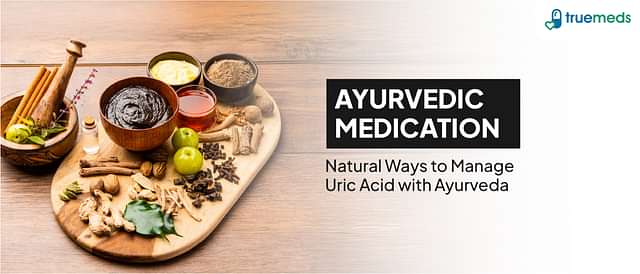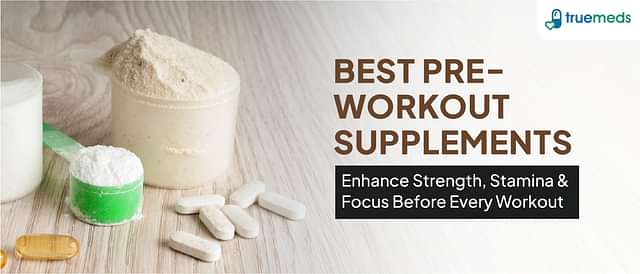Effective Ringworm Treatments: Home Remedies and More
Last updated on : 10 Oct, 2024
Read time : 12 min
Introduction
Ringworm is a common fungal infection that many of us might encounter at some point in our lives. Despite its name, it has nothing to do with worms. It can affect various parts of our body, causing itchy, red, circular rashes that are often quite uncomfortable. Understanding how to treat ringworm effectively is essential for a speedy recovery and to prevent it from spreading to others. This guide will walk you through what ringworm is, the different treatments available, and how we can manage it using prescription medications, over-the-counter products, and home remedies for ringworm.
What is Ringworm?
Ringworm, also known as tinea, is a fungal infection that affects the skin, scalp, or nails. It is caused by fungi called dermatophytes, which thrive in warm, moist environments. It is of many types. The most common ones include athlete’s foot (tinea pedis), Jock itch (tinea cruris), scalp ringworm (tinea capitis), nail infection (tinea unguium), and body ringworm (tinea corporis). Ringworm is highly contagious and can be spread through direct contact with an infected person, animal, or contaminated objects like towels or clothing. The infection appears as a red, circular rash with a clear centre, often resembling a ring. Symptoms include itching, scaling, and sometimes blisters. Although it can be uncomfortable and unsightly, ringworm is generally not serious and can be treated effectively with proper care and medication.
Ringworm Treatment
Treating ringworm promptly is crucial to alleviate symptoms and prevent the infection from spreading. Treatment typically involves antifungal medications, which can be applied topically or taken orally, depending on the severity and location of the infection. In addition to medical treatments, maintaining good hygiene and keeping the affected area clean and dry are essential steps in the healing process. Let’s explore the different treatment options available, including prescription medications, over-the-counter products, and natural remedies that we can use at home.
Prescription Ringworm Treatment
When ringworm is severe or doesn’t respond to over-the-counter treatments, prescription medications might be necessary. These are usually stronger and more effective at combating stubborn infections. Here are some common prescription treatments:
Oral Antifungal Medications
For widespread or severe infections, oral medications work from the inside out to eliminate the fungus. Here is the list of prescribed medications for ringworm:
- Griseofulvin: Griseofulvin is very effective for ringworm treatment. It is typically prescribed for severe cases of ringworm that do not respond to topical treatments. It is often used for infections of the scalp (tinea capitis) and nails (onychomycosis), which are difficult to treat with topical medications alone. Griseofulvin is available in oral forms, including tablets, capsules, and liquid suspensions. It works by inhibiting the growth of fungi. It binds to keratin, a protein in our skin, hair, and nails, making them resistant to fungal infections. This action prevents the fungi from growing and spreading. This medicine should be taken with a high-fat meal to enhance absorption. The dosage and duration depend on the severity and location of the infection. For example, scalp infections may require treatment for 6-8 weeks, while nail infections might need several months of therapy.
The Common side effects of Griseofulvin include headache, nausea, vomiting, diarrhoea, and dizziness. Some people may experience allergic reactions such as skin rashes. Long-term use can affect liver function, so regular monitoring may be necessary.
- Itraconazole: Itraconazole is an effective ringworm medicine for treating severe fungal infections. It is particularly effective for infections that affect the nails and scalp, as well as widespread skin infections. Itraconazole is available in oral forms, including capsules and liquid solutions. It inhibits the synthesis of ergosterol, an essential component of fungal cell membranes. Without ergosterol, the fungal cells become porous and eventually die. Itraconazole capsules should be taken with food to improve absorption. The liquid form, however, should be taken on an empty stomach. The treatment duration can vary from a few weeks to several months, depending on the infection’s severity and location.
The Common side effects of Itraconazole include nausea, vomiting, abdominal pain, diarrhoea, and headache. Serious side effects can include liver toxicity, heart failure, and allergic reactions. Regular liver function tests are recommended during treatment.
- Terbinafine: Terbinafine is a ringworm medicine is prescribed for treating infections of the skin, hair, and nails, especially when topical treatments are ineffective. It is particularly useful for nail infections and athlete’s foot. Terbinafine is available in both oral forms (tablets) and topical forms (creams, gels, and sprays). It works by inhibiting an enzyme called squalene epoxidase, which is essential for fungal cell membrane synthesis. This leads to the accumulation of toxic substances within the fungal cells, causing their death. Oral terbinafine should be taken with or without food. The usual treatment duration for nail infections is 6-12 weeks, while skin infections may require 2-4 weeks of treatment.
The Common side effects of Terbinafine include gastrointestinal issues (nausea, diarrhoea, and abdominal pain), headache, and skin rashes. In rare cases, it can cause liver problems, so liver function tests may be needed during prolonged use.
- Fluconazole: Fluconazole is used to treat various fungal infections, including ringworm, especially when topical treatments fail or the infection is extensive. It is also effective for fungal infections of the nails and scalp. Fluconazole is available in oral forms (tablets and liquid suspensions) and as an intravenous injection. Fluconazole works by inhibiting an enzyme required for fungal sterol synthesis. This disrupts the cell membrane formation, causing leakage of cellular contents and death of the fungal cells. It can be taken with or without food. The dosage and duration depend on the type and severity of the infection. A single dose may be sufficient for mild infections, while severe infections may require a longer course of treatment.
The Common side effects of fluconazole include headache, nausea, abdominal pain, diarrhoea, and dizziness. Serious side effects can include liver toxicity, severe allergic reactions, and changes in heart rhythm. Regular monitoring may be necessary for long-term use.
Topical Antifungal Creams
Topical creams are applied directly to the affected area, these creams contain powerful antifungal agents that kill the fungus and prevent it from spreading. One of the prescription creams effective for ringworm is Terbinafine.
Using these treatments as directed by a healthcare provider is essential for effective recovery. It’s important to complete the full course of medication even if symptoms improve, to ensure the infection is completely eradicated.
Over-the-Counter Ringworm Treatment
For mild cases of ringworm, over-the-counter (OTC) treatments can be quite effective. These are readily available and easy to use. Common OTC ringworm treatment include:
- Antifungal Creams and Ointments: An antifungal ointment or cream often clears ringworms on the skin. Most of these medicines you apply twice a day for two to four weeks. Many of these approved medicines are safe and effective for children. If the ringworm covers a large area of skin, you may need to take a prescription antifungal medicine. Products containing clotrimazole, or miconazole effectively kill ringworm fungus and relieve symptoms.
- Antifungal Sprays and Powders: These are useful for treating large or hard-to-reach areas. It is particularly beneficial for an athlete’s foot and jock itch. Sprays and powders help keep the area dry and free from moisture, which inhibits fungal growth.
- Antifungal Shampoos: For ringworm treatment on scalp, medicated shampoos containing ketoconazole or selenium sulfide are often used. These shampoos may stop scalp ringworm from spreading and soothe the scalp. Although it won’t cure it, it may be able to control the infection. In addition, you will need to take an oral antifungal medication prescribed by your doctor. It may be beneficial for family members who are not affected by the disease to use the shampoo as well.
Regular application as per the instructions on the packaging, is crucial for these treatments to work effectively. Avoid creams containing steroids (or corticosteroids) to deal with ringworm or a rash that would be ringworm.
Many over-the-counter ointments and lotions offered for rashes contain corticosteroids. The use of corticosteroids for ringworm infections can make them worse. They weaken the skin’s ability to combat the fungus, allowing it to spread to other parts of the body. They also can cause burning and redness to be more significant and severe. Corticosteroids can cause ringworm rashes to appear terrible, making it more difficult for a doctor to diagnose if you later want to seek care.
Also Read: Home Remedies for Scalp Fungal Infections
Ringworm Treatment at Home
In addition to medical treatments, ringworm treatment at home can also help manage its symptoms and promote healing. These methods are simple and can be easily incorporated into our daily routine:
- Keep the Affected Area Clean and Dry: Wash the area with soap and water, then dry thoroughly. Moisture can promote fungal growth, so keeping the area dry is essential.
- Avoid Sharing Personal Items: Do not share towels, clothing, or other personal items to prevent the spread of infection.
- Avoid contact: After contact with someone with a severe fungal infection.
- Wear Loose, Breathable Clothing: Tight clothing can irritate the affected area and worsen the infection. Opt for loose-fitting, breathable fabrics to reduce irritation.
Natural Ringworm Treatment
For those who prefer natural remedies, several options can help treat ringworm effectively. These remedies use ingredients that are often found in our kitchens and are gentle on the skin. Here are 6 simple home remedies for ringworm:
- Tea Tree Oil: Tea tree oil is effective for ringworm treatment due to its antifungal properties. It can be applied directly to the affected area. Those with sensitive skin may need to dilute it. Make a 2 percent dilution of tea tree oil by mixing 12 drops of the essential oil with 30 ml of coconut oil. Apply this to the skin three times daily. Those who do not have sensitive skin may be able to apply the tea tree oil directly to the affected skin without diluting it first.
- Coconut Oil: Coconut is effective for ringworm treatment due to its natural antifungal properties. It can soothe the skin and help reduce the fungus. Certain fatty acids in coconut oil can kill fungal cells by disrupting their cell membranes. According to several studies, coconut oil may be a useful treatment for mild to moderate skin infections. To treat ringworm, apply liquid coconut oil to the skin thrice daily. You can also use coconut oil as a moisturiser, which may help prevent subsequent ringworm infections.
- Apple Cider Vinegar: Apple cider vinegar has antifungal activity against Candida, which is a fungal infection. Its acidic nature can help kill the fungus. To cure ringworm with apple cider vinegar, soak a cotton wool pad in undiluted vinegar and apply it to the affected region. Repeat up to three times a day. However, be mindful of the side effects of over-consuming apple cider vinegar to avoid any adverse reactions.
- Aloe vera: Aloe vera contains six antiseptic agents that, showcase antifungal, antibacterial, and antiviral activities. Apply the gel from an aloe vera plant onto the ringworm patch 3 or four times every day. The gel additionally has cooling properties, so it is able to soothe itchy and inflamed skin.
- Garlic: Garlic is frequently used to treat infection for different varieties of fungi, along with Candida, Torulopsis, Trichophyton, and Cryptococcus. To use garlic as a treatment, crushed garlic cloves and mix it with a few olive or coconut oil. Apply this paste to the affected skin and cover it with gauze. Leave in for up to 2 hours before rinsing. Repeat twice each day until the skin clears up. If the garlic paste causes stinging, swelling, or redness, rinse off immediately and do now not reapply.
- Turmeric: Turmeric is a famous ringworm treatment because of its anti-inflammatory properties. It also contains curcumin, which exhibits antimicrobial properties. Consume turmeric as a tea or add it to your meals. To apply turmeric paste, blend it with a small quantity of water or coconut oil until you get a paste, then apply it to the skin. Leave it to dry before wiping it off.
These natural treatments can be effective, especially when used consistently.
Also Read: Parasitic Worms and Treatment
Key Takeaways
Ringworm, is a common fungal infection marked by ring-shaped, red, scaly patches on the scalp, arms, legs, face, and trunk. The mild infection can be effectively treated with simple home remedies and OTC medications like clotrimazole, miconazole, ketoconazole or selenium sulfide. If symptoms do not clear up within 2 weeks of doing ringworm treatment at home, then it may be necessary to see a doctor. In that case, prescription medications are necessary. Besides the treatment, maintaining good hygiene, avoiding sharing personal items, and keeping the affected area clean and dry are crucial steps in managing ringworm. By understanding these treatment options, we can quickly and effectively address ringworm and prevent its spread.
FAQ
To get rid of ringworm quickly, use OTC available antifungal creams containing clotrimazole, or miconazole and oral medications as prescribed, and keep the affected area clean and dry.
Ringworm typically does not go away on its own and requires the combined therapy of antifungal medications and home remedies to clear up completely.
Antifungal creams, ointments, sprays, oral medications, and maintaining proper hygiene can effectively kill ringworm in humans.
The fastest way to cure ringworm is to use prescription antifungal medications and follow a strict hygiene routine.
To naturally remove ringworm scars, apply aloe vera gel, coconut oil, or vitamin E oil to the affected area regularly. These ingredients can help lighten scars and promote healing.
Disclaimer
Our healthcare experts have carefully reviewed and compiled the information presented here to ensure accuracy and trustworthiness. It is important to note that this information serves as a general overview of the topic and is for informational purposes only. It is not intended to diagnose, prevent, or cure any health problem. This page does not establish a doctor-patient relationship, nor does it replace the advice or consultation of a registered medical practitioner. We recommend seeking guidance from your registered medical practitioner for any questions or concerns regarding your medical condition.
Popular Articles
Recommended Articles
Recent Articles
Top-Selling Medicines:
...View more
Top-Selling OTC:
...View more
Company
About UsHealth ArticleHealth StoriesDiseases & Health ConditionsAll MedicinesAll BrandsNeed HelpFAQSubscribe
Registered Office Address
Grievance Officer
Download Truemeds

Contact Us
Our customer representative team is available 7 days a week from 9 am - 9 pm.
v3.7.8
Our Payment Partners









